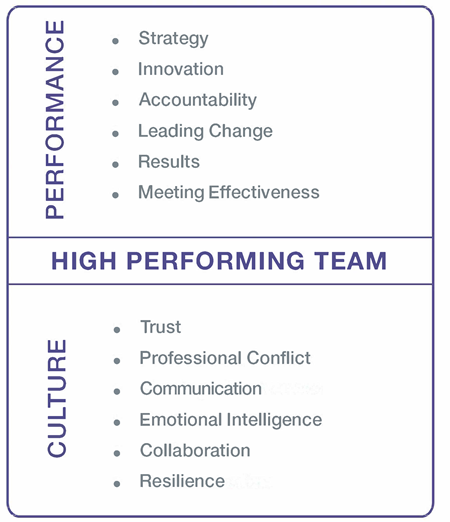Our solutions cover the entire employee lifecycle from selection through to development, focusing on individuals, teams and organisational solutions.
Building High Performing Teams - Part 1

Authored by: Dr Lynne Cruickshank, Senior Consultant, PBC
What does a high performing team look like?
Teams play a valuable role in organisations and when seeking to establish a high performing team, one factor that should be taken into consideration is personality. Research recently conducted by PBC found that various aspects of personality were associated with team performance measured by the High Performing Team Assessment (HPTA), with the key highlights and implications summarised below.

The HPTA Model
Strategy
Strategy focuses on defining, reviewing and sharing strategic priorities for the team that enable organisational goals to be met (Huang, 2009). Teams with a greater shared understanding about their purpose and direction have been found to be more likely to make better decisions and adapt more effectively to organisational demands (Resick et al., 2010).
In the research recently conducted by PBC, teams with higher levels of emotional stability, competitive drive, and a preference for social interaction were found to have higher levels of performance in relation to strategy. This suggests that teams may be able to enhance their performance in this area by building their level of resilience, taking greater initiative to identify opportunities to achieve results, and engaging with other team members more readily to define, review and share strategic priorities for the team.
Teams that tended to manage pressure by distancing themselves from others, including by withdrawing socially and being uncommunicative were more likely to perform more poorly in relation to strategy. Poorer performing teams also tended to be cynical and mistrustful of others, preferred to work according to their own agenda or timetable, and were inclined to express their feelings in indirect ways (e.g. procrastination). Teams are likely to benefit from strategies to minimise the negative impact of these behaviours on their performance such as strategies focused on fostering trust and developing more open communication.
Innovation
Teams that are proactive in fostering innovation and thinking creatively are more likely to respond effectively to unanticipated changes and adversity and create more value for their organisations through developing new and different ideas and approaches. Teams with higher levels of emotional stability were found to perform better in relation to innovation. However, teams that tended to be overly sceptical and cynical of others and prone to being fault-finding and argumentative tended to perform more poorly in relation to innovation. Preferring to work alone when under pressure was also related to poorer performance for innovation.
To enhance innovation, teams should ensure that they spend sufficient time exploring different ideas and perspectives without quickly jumping into fault-finding mode. They should also consider strategies to manage their emotions appropriately when there are differences of opinion.
Leading Change
Navigating change effectively, as well as being proactive in identifying opportunities to capitalise on change both internally and externally, is a key mechanism that enables teams to improve their effectiveness and their ability to improve organisational outcomes (Talke et al., 2011). Adopting a more proactive change focus also helps teams navigate ambiguity and cope better with the stress associated with change (Rafferty & Jimmieson, 2010).
Unsurprising, valuing history and convention and preferring consistency, predictability and minimising risks were found to be negatively related to team performance in relation to leading change. These teams are likely to benefit from applying strategies to be more adventurous, explore alternative approaches and to take more calculated risks. Teams that were more likely to question the motive or rationale behind change initiatives and who preferred to work according to their own agenda were also found to have lower performance in relation to leading change. These teams are likely to benefit from considering how they can be more open-minded about potential change initiatives including taking the time to explore the expected benefits associated with these initiatives rather than quickly focusing on the potential issues and limitations.
Read more in Part 2.
